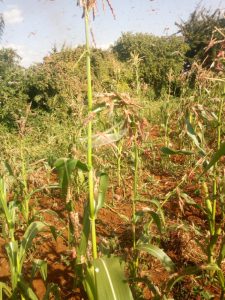Livelihoods Protection and Restoration
The objective of this component is to support DL affected households to restore their productive assets for enhanced adaptation and resilience. The component will support initiatives to enhance access to food and to rehabilitate food production systems and livelihoods that have been damaged by DL swarms. The achievement of this objective will be assessed through tracking affected crop and livestock-holding households receiving input packets, emergency feed and fodder seeds and those receiving replacement livestock.
To safeguarding food security and protecting human capital, the project will support protection of the poor and vulnerable households in locust affected areas from livelihood and asset loss, by enhancing the purchasing power to meet food and other basic needs. The beneficiaries will be identified and linked to ministries and departments responsible for social protection. Direct support will be given in form of livestock feed, fodder and seeds. The project will also support vulnerable households through linkages to ELRP’s community micro projects and subprojects to provide both skilled and unskilled labour for cash (cash for work programs) to smoothen consumption
The component will promote the adoption of climate-smart crop and livestock practices for reduced GHG emissions, enhanced resilience, through the implementation of livelihood support/diversification initiatives. Livelihood diversification will emphasize alternative livelihood activities that are less dependent on changes in weather and climate variability. The areas of support will include:-:- i) crops and livestock TIMPs/packets to restore livelihoods; ii) Community projects to rehabilitate degraded pasture and crop lands, enhancing storage capacity for feed and produce; iii) strengthen producer organizations to upscale their operations – input bulk purchasing; storage, value addition, marketing; iv) emergency response for immediate restoration of pastures, food security v)Livelihood diversification will emphasize alternative livelihood activities
The livelihood rehabilitation activities will include: –
Restoration of pasture and fodder in areas degraded by the locust upsurge will be achieved through various interventions: –
- Train affected households on pasture, livestock management, land and soil management; climate-resilient grazing management and alternate enterprises that can be adopted in the specific area.
- Provide support for animal health and husbandry advisory services.
- Support to pastoral and agro-pastoral households through provision of feeds and water to avert further livestock losses.
- Provide input packets and reseeding to re-establish denuded pasture fields.
- Support households to establish low capital enterprises to generate quick incomes – such as indigenous chicken rearing, apiculture among others and improve their nutrition.
- Establish or improve storage capacity for conserved pastures and fodder.
- Support market linkages, aggregation livestock for rapid off take, value addition, and post-harvest management.
- Establishment of tree nurseries by the youth and women, and establishment of woodlots to reduce wind and sheet erosion.
- Promote agroforestry initiatives for nutrition, income and environmental improvement.
- The project will promote alternative technologies, innovations and management practices to improve soil fertility and water retention.
Establishment of legumes and grasses adapted to the local environment- interventions will involve introduction of diverse and appropriate crops, grass and legume species together with management and utilization practices. The project will provide assorted inputs; seeds and training on establishment, management and utilization of these crops, grass and legume species to replace loss of the natural flora.
Restocking will be facilitated in areas where livestock keepers have lost stock and their source of livelihood due to pasture and fodder destruction following DL invasion. The following activities will be undertaken to support livestock restocking: –
- Support for restocking the same species of animals together with the necessary backstopping and feed resources.
- Enhance restoration of livelihood by introducing alternative/diversified livestock enterprises to spread risk. e.g. poultry so that farmers can eventually graduate to the bigger stock. This process will include capacity building and necessary backstopping at the various stages.
- Allied services for the improvement of the enterprises shall be included in the restocking processes (animal health, breeding services, feed supply, conservation of feeds amongst others)
- Enhance waste management by reducing emission of GHG through the introduction of biogas to produce green energy and manuring to improve soil condition and fertility.
- Restoration of crop production, food security and livelihoods in areas affected by the locust upsurge will be achieved through the following interventions: –
- Provision of crop-based inputs that are specific to the needs of the beneficiaries to enable them re-establish crops that were adversely affected by locust invasion. The inputs will include suitable seeds, fertilizers and pesticides (both production and post-harvest).
- Support households to establish low capital enterprises to provide quick incomes, such as kitchen gardens to enhance the beneficiaries’ nutrition and incomes.
- Promotion of alternative livelihoods for income generation, food security and resilience – such as sorghum and millet production.
- Promote fruit and vegetable production, through small irrigation equipments/facilities.
- Capacity development on production and post-harvest management.
- Linkages to service providers – farmers will be linked to existing POs and other service providers for services such as produce aggregation, value addition and market access.
- Establish/improve storage capacity for farm produce.
- Promote alternate technologies, innovations and management practices to improve soil fertility and water retention.
Crops that enhance the pollinator insect populations will also be promoted.

